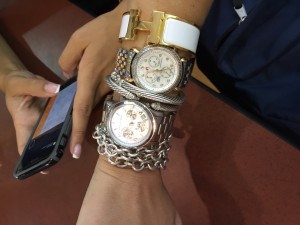Walkin’ round with straight cash money on your wrist
March 4, 2016

Staff report
Walking around school with a Lululemon lunch bag comes at a cost. A cost of about $88, assuming you are buying the basic black cropped Lululemon leggings, the same ones available at Target for a quarter of the price. And if you want the bangle with an “H” on it, that’ll be $600, or the ring with a band that looks like twisted rope, that’ll be $675 at the least (otherwise known as the Hermès enamel H bracelet and David Yurman Albion ring).
Oddly, or not so oddly, these are commonly worn by West Essex students and teens across the nation. This is not a criticism or a promotion, but rather a reflection on teen culture in today’s society.
Designer items on the hands, wrists and bodies, of 16 year old boys and girls, go relatively unnoticed. A $675 ring has no shock value to fellow students. To me, that is actually the most shocking part of the situation.
In August, Kylie Jenner posted a $10,000 Hermès Birkin bag she received for her 18th birthday on Instagram for her 50-plus-million impressionable followers to see. Though a Birkin bag is a bit extravagant and an unrealistic comparison to the level of designer items seen within our own school, it successfully models how social media has the power to influence the youth’s perception of what is considered normal.
“My camp friends wear whatever they have everywhere they go. They all definitely care about how they look when other people are around,” senior Madi Yuran said.
The truth of the matter is that people often pride themselves on how they are perceived by others. So, maybe there is more concrete and underlying reason as to why designer items have essentially become staples for teens: they are simply the new baseline for fitting in. According to Business Insider, Lululemon has been pinpointed as a brand on the rise among teens, having become 6 percent more popular in sales since spring 2015.
Overwhelmingly, teens are spending the majority of their money on apparel; 21 percent of teen spending belongs solely to clothing. The luxury customer is getting increasingly younger as stores target teens with tactics like dim lighting, loud music and lesser collections to expand access to exclusive designers.
I am not saying across the board, everywhere you look, high schoolers are decked out in uber expensive, exclusive items. That would be inaccurate and naive. What I am describing is the evolution of youth culture from previous generations, not a nonexistent epidemic. I would imagine when our parents were our age they were not nearly as preoccupied with material goods. Something has shifted in our sense of what is socially acceptable, yearned for and praised, in today’s society.
Whether we like it or not, we are walking advertisements. I can honestly reflect on the student body here at West Essex and say we are relatively humble. Students are not purposely showy and do not belittle others for what they may not have, especially compared to other schools and the way social media projects high school teens.
What made this the new normal does not boil down to one cause. Though social media and surroundings (both geographical and social) are contributing factors, time takes precedence. The evolution of a trend or standard is not possible without time. The future will bring an even ‘newer normal’ that can’t even be grasped now.
Every generation is shaped by the world around them, so instead of trying to dissect what constitutes normal, maybe we should try to understand why it is the way it is, and if necessary, change it.
